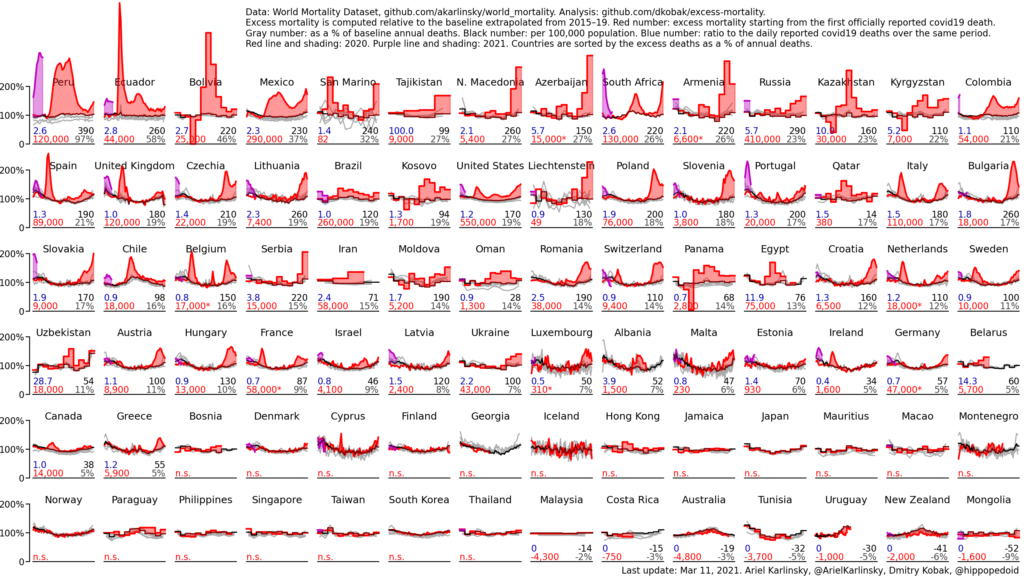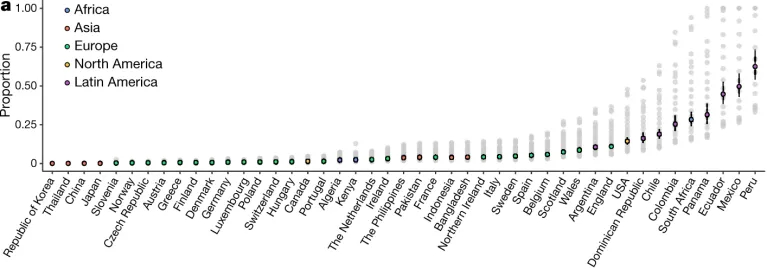Covid-19 Mortality: An Overview
COVID19 - CORONAVIRUS, 15 Mar 2021
Swiss Policy Research - TRANSCEND Media Service
11 Mar 2021 – An Overview of Covid-19 Mortality per Country
A) Excess mortality ⇓ B) Life expectancy ⇓ C) Nursing homes ⇓ D) Countries ⇓
A) Excess Mortality Per Country
The following live chart, developed by Ariel Karlinsky and Dmitry Kobak, shows excess mortality per country, compared to the 2015-19 baseline, since the beginning of the pandemic. In most Western countries, the covid pandemic increased mortality by about 5% to 20% until March 2021, but in some Latin American countries, mortality increased by up to 100%.
These figures refer to all-cause excess mortality and may include non-covid excess deaths. Official data from the US and the UK indicate that in some countries, up to one third of all excess deaths may not be due to covid, but due to indirect effects of the pandemic and lockdowns.
Please enlarge the chart to see details. The red number indicates excess deaths since the start of the pandemic; the black number indicates excess deaths per 100,000 population; the grey number, excess deaths compared to annual baseline; the blue number, ratio of excess deaths to reported covid-19 deaths (i.e. undercounting or non-covid excess deaths). Red line is 2020, purple is 2021.
Covid mortality depends on the infected population proportion as well as on demographics (e.g. age structure) and health indicators (e.g. cardiovascular disease prevalence). By the end of 2020, infection attack rates ranged between 10% and 30% in most Western countries and between 25% and 50% in many Latin American countries. The following chart shows the infection attack rate per country as of 1 September 2020, i.e. prior to the second wave.
B) Impact on Life Expectancy
Life expectancy is a theoretical concept describing the average age people born in a certain year will reach, assuming that the mortality rate per age of that year will stay constant forever. As a pandemic is a transient event, life expectancy will likely return to its pre-pandemic levels after the pandemic subsides, unless there are significant, population-wide long-term health sequelae.
The following chart, developed by José Manuel Aburto et al., shows the temporary impact of the covid pandemic on life expectancy per country. Specifically, it shows the change in life expectancy in 2020 (negative in most countries), at birth and at age 60, for males and for females, compared to the average yearly change in life expectancy between 2015 and 2019 (positive in all countries).
In most countries, the median age of covid deaths was close to the average life expectancy or even slightly above (e.g. 78 years in the USA and 80 to 86 years in Western Europe). Therefore, despite high excess mortality in some countries, the impact on life expectancy was limited.
As can be seen, the temporary decrease in life expectancy in 2020 ranged from zero (in countries hardly affected by the coronavirus) to minus 2.1 years in US males. For comparison, the 1918/19 “Spanish flu” pandemic, which in contrast to covid killed many young people, lowered US life expectancy by about 15 years, from 55 years to 40 years. Thus, the “Spanish flu” had lowered US life expectancy about eight times more than covid did in 2020 (see below).
__________________________________________
 Swiss Policy Research, founded in 2016, is an independent, nonpartisan and nonprofit research group investigating geopolitical propaganda in Swiss and international media. SPR is composed of independent academics that for personal and professional reasons prefer to protect their identities, and receives no external funding; there are no financial sponsors or backers. Our articles have been published or shared by numerous independent media outlets and journalists, among them Julian Assange, and have been translated into more than two dozen languages.
Swiss Policy Research, founded in 2016, is an independent, nonpartisan and nonprofit research group investigating geopolitical propaganda in Swiss and international media. SPR is composed of independent academics that for personal and professional reasons prefer to protect their identities, and receives no external funding; there are no financial sponsors or backers. Our articles have been published or shared by numerous independent media outlets and journalists, among them Julian Assange, and have been translated into more than two dozen languages.
Tags: Airborne contagion, COVID-19, China, Community, Compassion, Coronavirus, Cuba, Economy, Empathy, Environment, Health, Lockdown, Orthomolecular Medicine, PCR Tests, Pandemic, Public Health, Research, Science, Science and Medicine, Swiss Policy Research, United Nations, Vitamin C, Vitamin D, WHO
DISCLAIMER: The statements, views and opinions expressed in pieces republished here are solely those of the authors and do not necessarily represent those of TMS. In accordance with title 17 U.S.C. section 107, this material is distributed without profit to those who have expressed a prior interest in receiving the included information for research and educational purposes. TMS has no affiliation whatsoever with the originator of this article nor is TMS endorsed or sponsored by the originator. “GO TO ORIGINAL” links are provided as a convenience to our readers and allow for verification of authenticity. However, as originating pages are often updated by their originating host sites, the versions posted may not match the versions our readers view when clicking the “GO TO ORIGINAL” links. This site contains copyrighted material the use of which has not always been specifically authorized by the copyright owner. We are making such material available in our efforts to advance understanding of environmental, political, human rights, economic, democracy, scientific, and social justice issues, etc. We believe this constitutes a ‘fair use’ of any such copyrighted material as provided for in section 107 of the US Copyright Law. In accordance with Title 17 U.S.C. Section 107, the material on this site is distributed without profit to those who have expressed a prior interest in receiving the included information for research and educational purposes. For more information go to: http://www.law.cornell.edu/uscode/17/107.shtml. If you wish to use copyrighted material from this site for purposes of your own that go beyond ‘fair use’, you must obtain permission from the copyright owner.
Read more
Click here to go to the current weekly digest or pick another article:
COVID19 - CORONAVIRUS:

